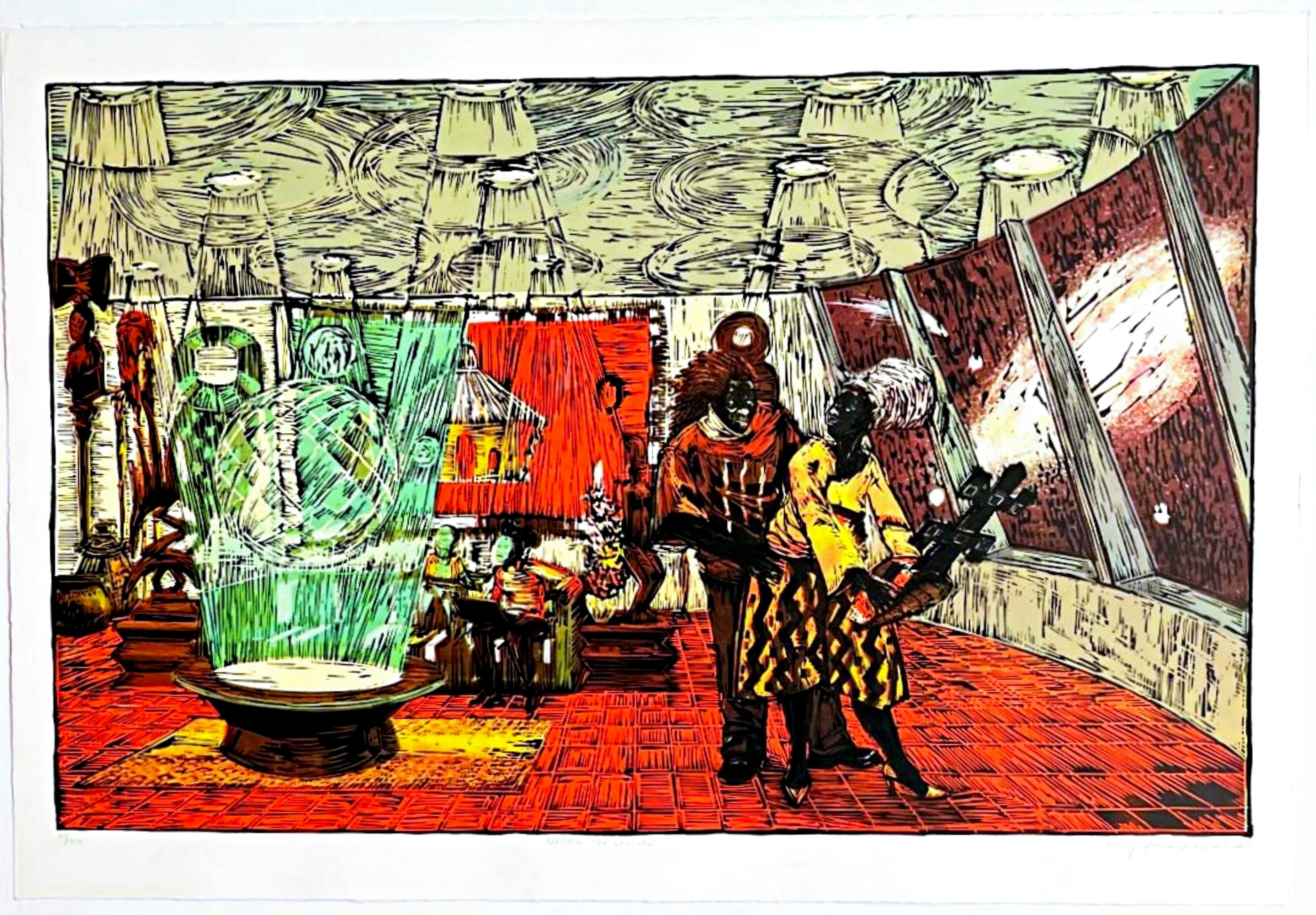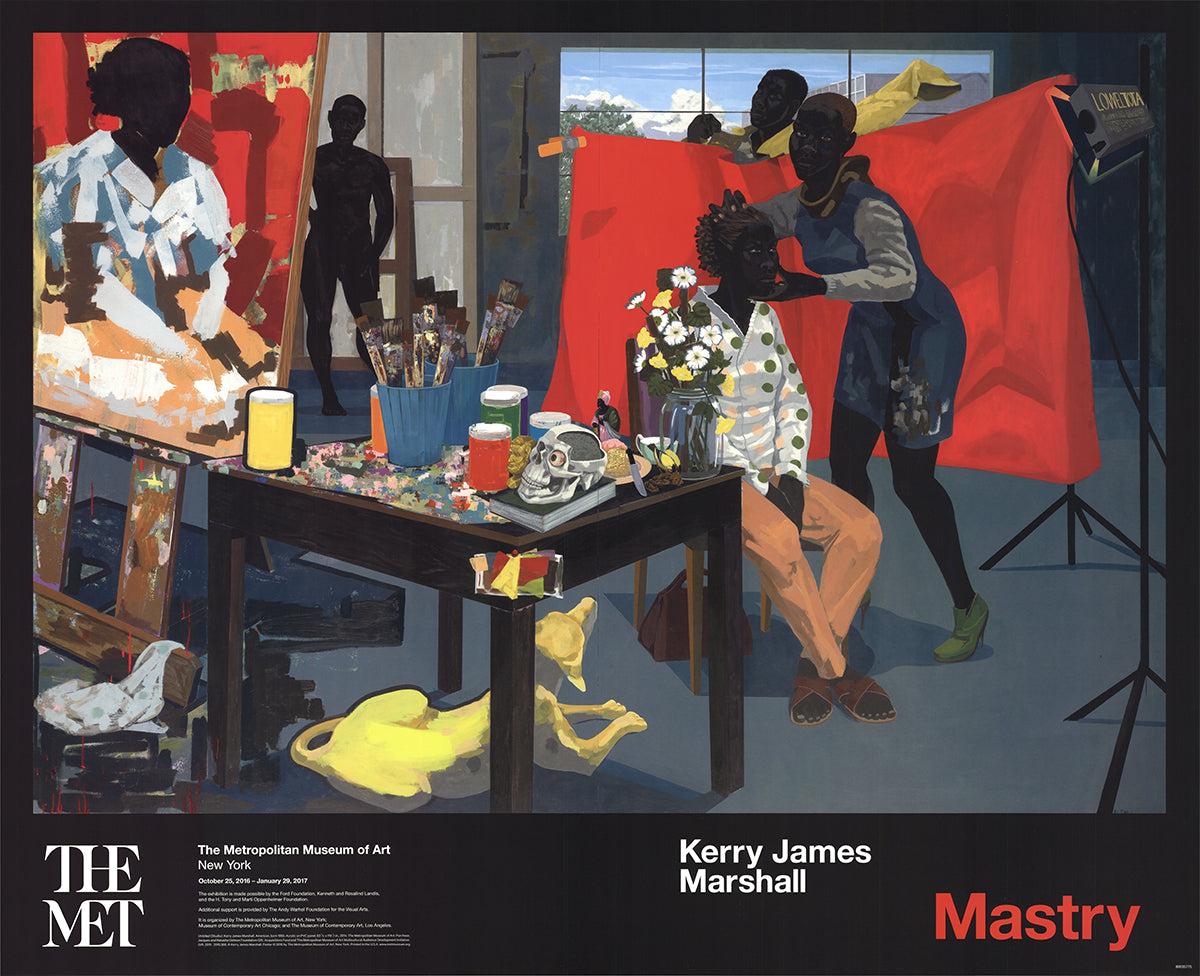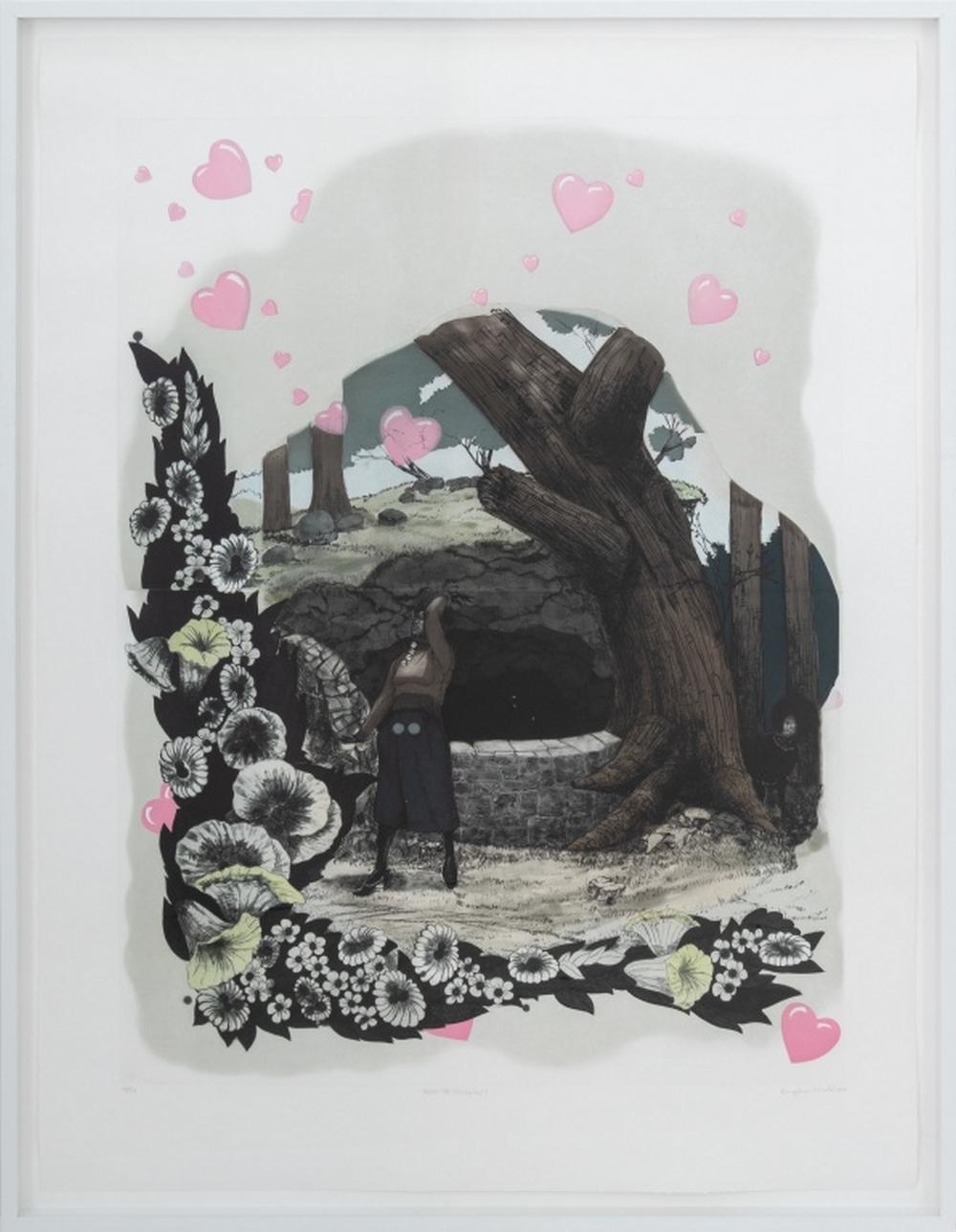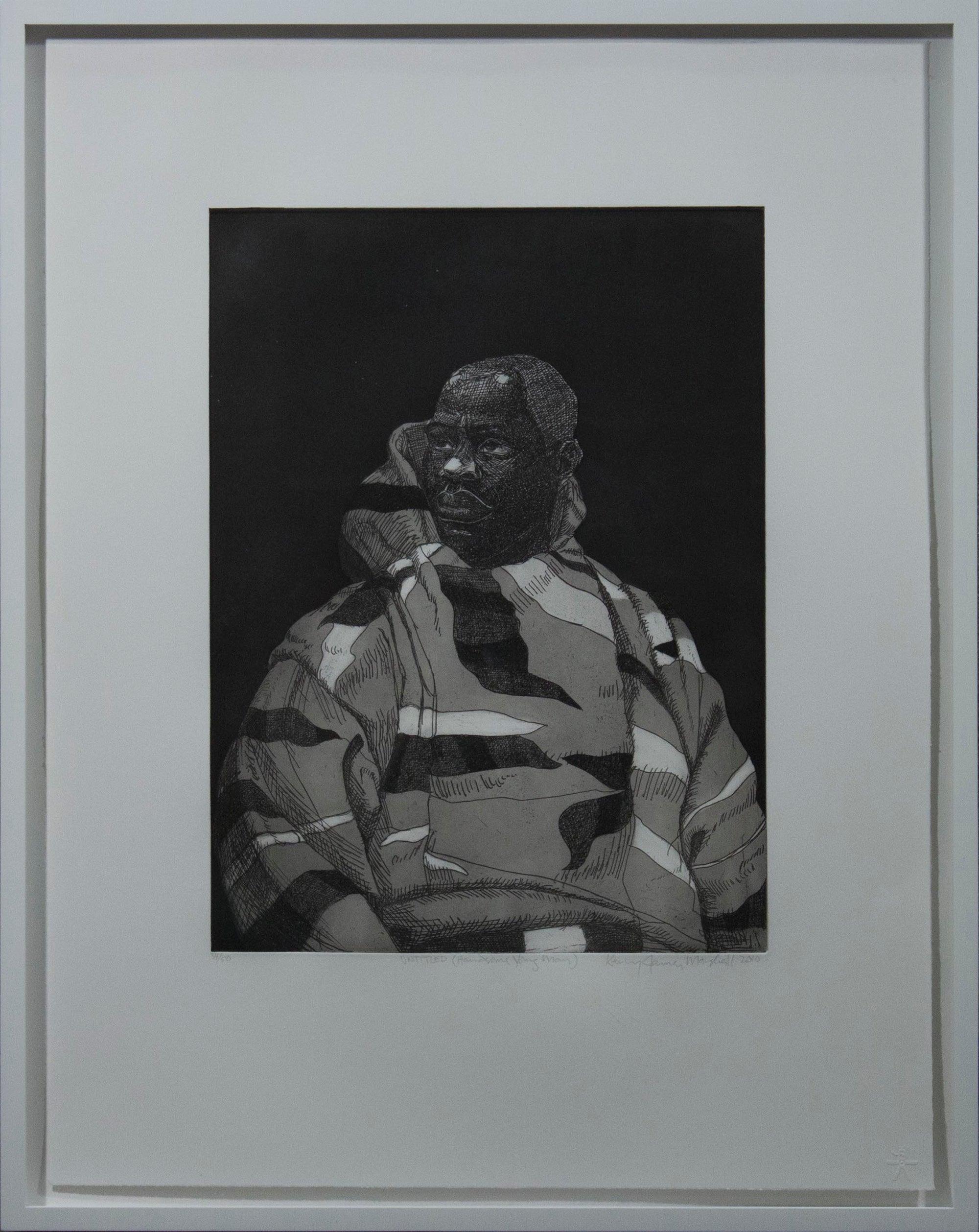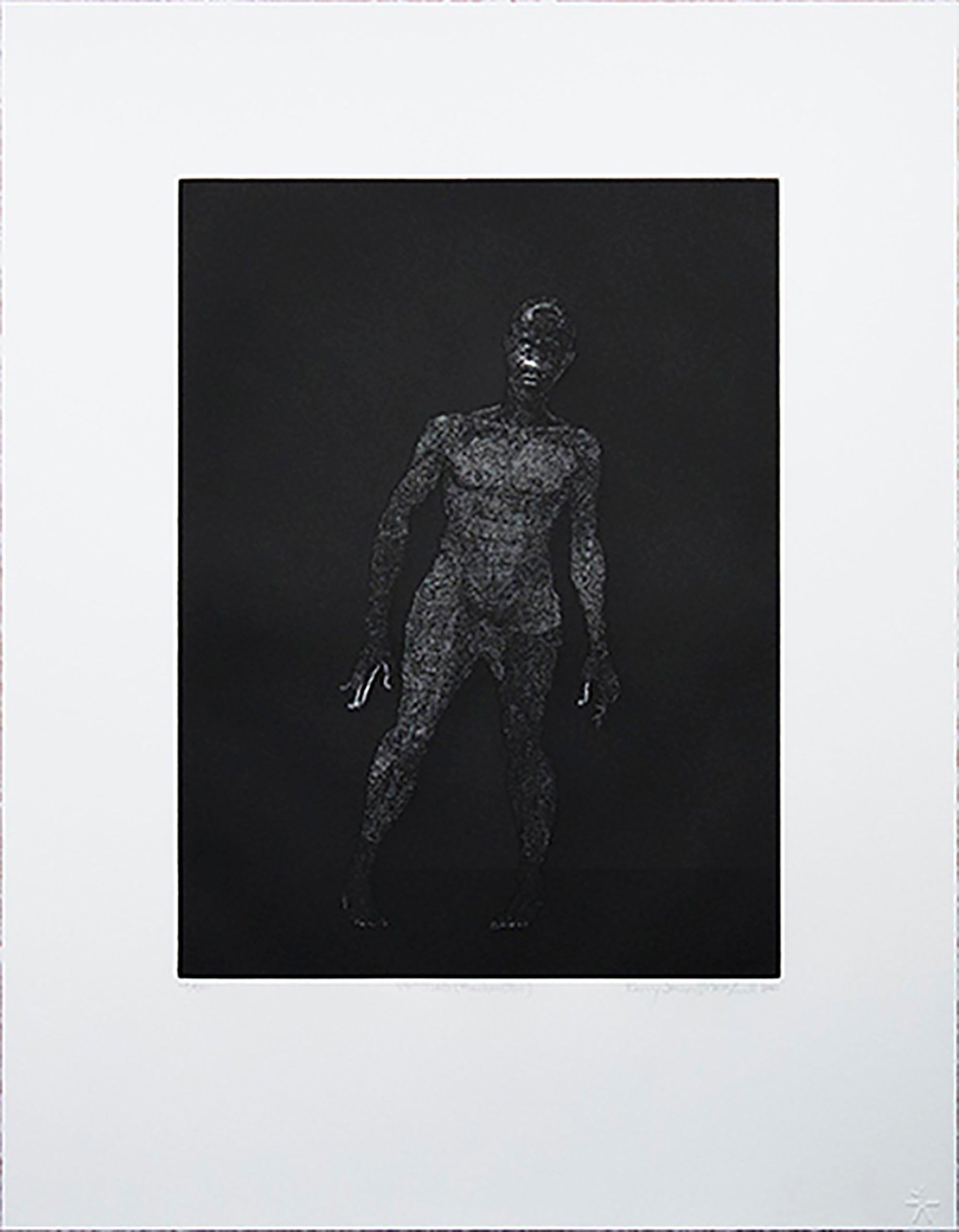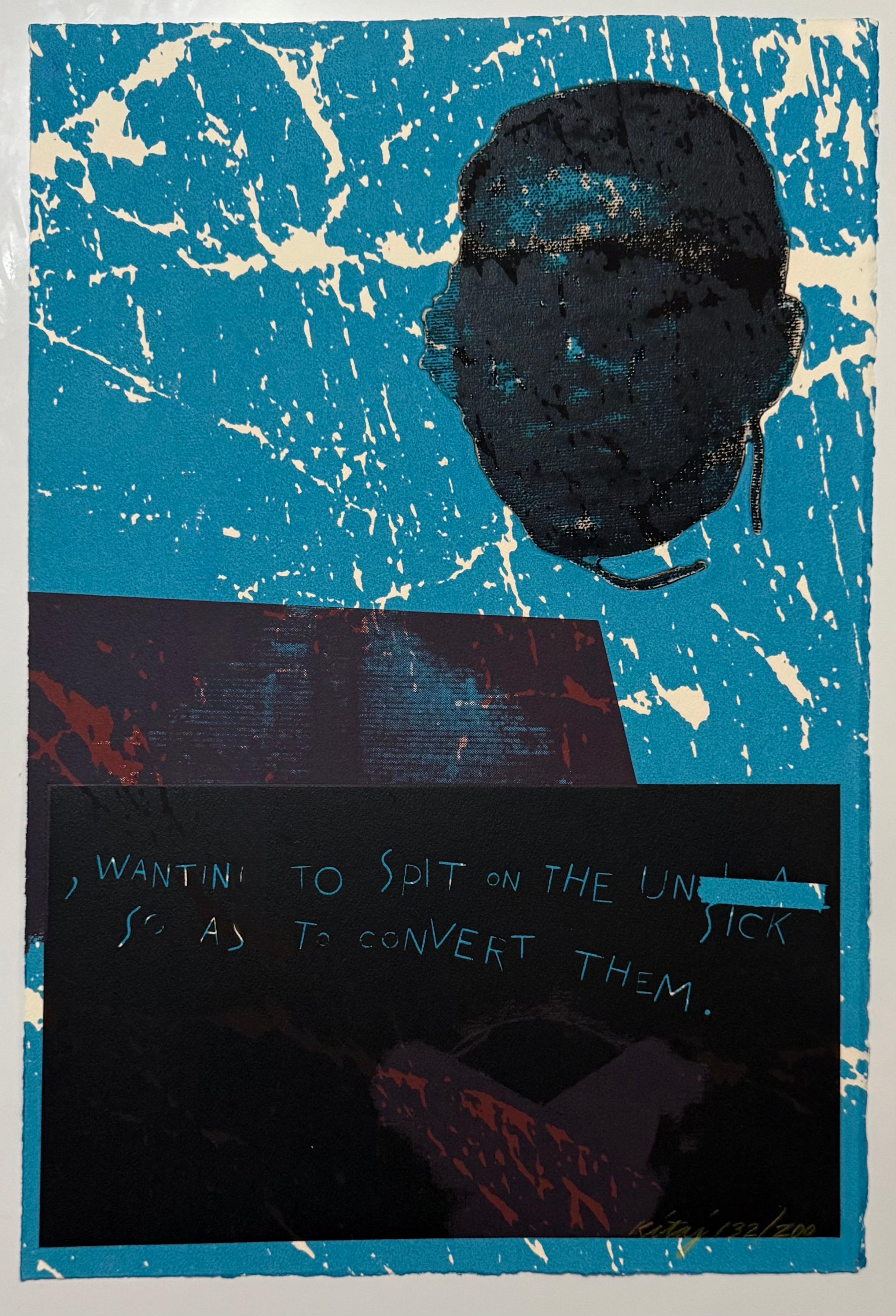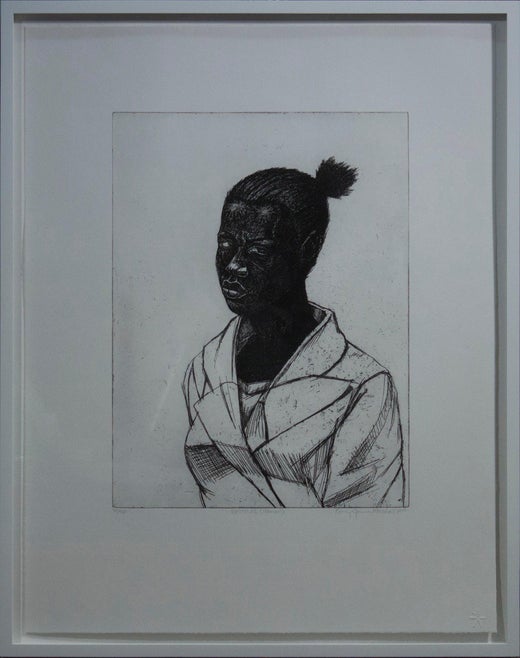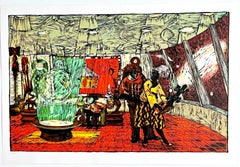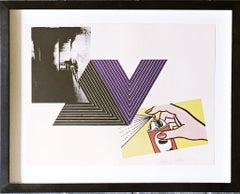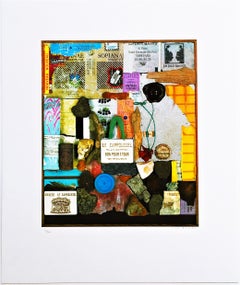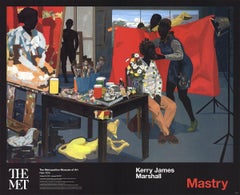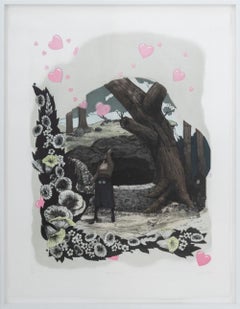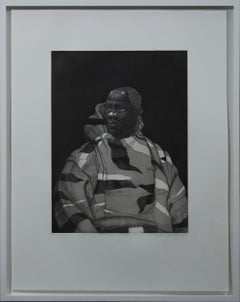Kerry James Marshall
May 15, 2001, 2003
Four color silkscreen on Arches 88 paper
Pencil signed, dated and numbered 39/60 on the front. Bears printer's blind stamp
Vintage frame included
Accompanied by xerox copy of the publishers' colophon page (see attached jpeg)
Published by the College Art Association, NY. Printed by the Brodsky Center for Innovative Editions, NY, with the blind stamp lower left.
Pencil signed, dated and numbered 39 from the edition of 60 on the front. Bears printer's blind stamp
Also bears artist's signature on sheet
Published by the College Art Association, NY. Printed by the Brodsky Center for Innovative Editions, NY, with the blind stamp lower left.
Rarely seen on the market, this the highly collectible Kerry James Marshall graphic work published by the College Art Association and printed at the Brodsky Center for Innovative Printmaking at Rutgers, done in collaboration with master printer Randy Hemminghaus. Created in 2003, this work represents themes relating to the commodification of art that would preoccupy the artist, and that he would reprise over the next two decades, culminating in his internationally acclaimed 2018 "History of Painting (May 16, 2007). (It didn't hurt that a bidder snagged one of his paintings at auction for over $21 million.) The present work, "May 15, 2001 resembles a grocery store’s advertising circular. Instead of depicting vegetables or canned goods, Kerry James Marshall “advertises” works by modern and contemporary artists, along with their auction prices, from a sale at Sotheby’s held on May 15, 2001. Like all of Marshall’s work, this image percolates with embedded references to the African American experience and the traditions of art history: the names of Caucasian artists and artists of color are intermingled and some are occluded; salient at upper left is a blurry, iconic little reproduction of Jeff Koons’s garish gilt ceramic portrait of Michael Jackson and his pet monkey, Michael Jackson and Bubbles (1988), from that artist’s Banality series. The figure, racially ambiguous and ambiguously parodic, sets off a sequence of reverberations that ripple through the image: Koons to Lichtenstein to Warhol to Pollock; Jackson to Basquiat to Puryear to Gallagher. Black and white artists intermingle, their values declared in fat, deadpan numbers and their boldface names claiming the visual space once granted to images. In this context, Basquiat’s tiny black silhouette Furious Man (1982) appears in skeptical dialogue with Koons’s more placid sculpture. In keeping with one of Marshall’s long standing preoccupations, May 15, 2001 makes layered references to art history. The artist slyly acknowledges the critical interventions of Hans Haacke and the Guerrilla Girls, who have harshly interrogated the financial underpinnings of the art world, and provides a tongue-in-cheek commentary on Warhol’s Campbell’s Soup cans, now temporarily restored to their original nonart place on the shelves of the American supermarket. In 2007, Marshall reprised this theme yet again: "..a group of paintings takes as its subject the way in which artworks are exchanged, emphasizing their ultimate fate as commodity. Appropriating the format of the supermarket circular, Marshall replaces the everyday goods that would ordinarily be promoted on such fliers with auction results, each from a different auction house and day in early 2007, when the market had reached an apex. One painting depicts results from Swann Auction Galleries, notably one of the only houses to offer a sale of African American artists, while others make evident the relative absence of women from such contexts. Embedded within is a series of purely aesthetic formal choices that are in direct contrast with their content—for example, the invocation of color theory or a riff on neo-plastic composition that unconsciously affects the lens through which these works are seen. Titled History of Painting, they call attention to how value is created and assigned and how it influences the writing of history." - courtesy David Zwirner press release for "History of Painting", October, 2018. (In December of 2018, Marshall revisited this imagery of auction prices in his exhibition Kerry James Marshall: History of Painting at David Zwirner, London)
Measurements:
Framed
30 inches vertical by 25 inches horizontal by 1.5 inches depth
Print
27.5 inches vertical by 23 inches
Marshall's pictures use a unique adaptation of the narrative tradition to condense aspects of the African American experience. As an artist raised in Birmingham, Alabama and later raised in Watts, his own life has taken place on the turbulent axes of black history in the States; in his artworks, Marshall commemorates this mixed and often troubled legacy through story and history, through the translation of personal experience. "I've always wanted to be a history painter on a grand scale like Giotto and Gericault" he reflects " but the moment when that kind of painting was really possible seems so distant, especially after Pollock and Polke. Nevertheless, I persist, trying to construct meaningful pictures that solicit identification with, and reflection on Black existential realities" (Kerry James Marshall in a letter to Arthur Jafa in the summer of 1994).
Marshall, along with his dealer, were voted by ArtReview the top two of the 100 most influential people in the art world of 2018, and ahead of figures like Jeff Koons, Larry Gagosian and Eli Broad! That year, none other than the editors of Artsy also voted him the most powerful and influential artist. His paintings now sell for tens of millions of dollars - after a famous collector paid $21 million for a painting. Today, his star continues to rise, Kerry James Marshall's works remain in demand in the marketplace, all the more so in 2026 when his much-anticipated blockbuster retrospective opened at the Royal Academy of Art in London.
For a feature profile/article written for Marshall's first retrospective - a blockbuster show entitled "MASRY" at the Museum of Contemporary Art, LA, the Museum of Contemporary Art Chicago and the Met Breuer in New York, Barbara Isenberg of the LA Times wrote: ." The New York Times called the show “smashing” and its subject “one of the great history painters of our time.” The New York Review of Books and Artforum magazine put large images from the show on their January covers. “I’ve been acutely aware that museums are behind their academic colleagues in terms of thinking of representation and people of color,” MOCA chief curator Helen Molesworth says. “I find Kerry’s paintings ravishing — they are drop dead, great paintings — and they have an extra level of reward for people who hold in their heads a history of Western painting.” Marshall is a compelling storyteller, whether on canvas or in conversation. Talking at length during a visit to MOCA, he is easygoing but eloquent, recalling his neighborhood in Birmingham, Ala., where he was born in 1955, or about growing up black there and in Los Angeles. He remembers the names of teachers who encouraged him. Asked when he first began to notice a lack of black subjects in museum artworks, Marshall answers a different question.
“You have to take an overview of how the culture is structured,” he says. “Even before I got to museums, I was interested in comic books. When you grow up looking at Superman, Batman and all those superheroes, you take it for granted that is what superheroes are supposed to be. So then, when I see art books at the library, and I’m seeing Leonardo da Vinci and Michelangelo and Rembrandt, I think that’s what artists look like. “..At a certain point, you have to decide whether you’d be satisfied always acknowledging the beauty and the greatness of what other people create or if you want to be in the same arena. You can’t keep saying that a superhero is a white guy with a square jaw and broad shoulders because every time you say that, it means you can’t be a superhero. You have to demonstrate that you believe you have the capacity to be a superhero too. Or the capacity to be an ‘old master.’”
KERRY JAMES MARSHALL BIOGRAPHY
Engaged in an ongoing dialogue with six centuries of representational painting, Kerry James Marshall (b. 1955) is known for his expansive body of work, which also includes drawings and sculptures. At the center of his oeuvre is the critical recognition of the conditions of invisibility long ascribed to Black figures in the Western pictorial tradition, and the creation of what he calls a "counter-archive" that brings them back into this narrative.
Marshall was born in Birmingham, Alabama. He received his BFA from the Otis Art Institute in Los Angeles in 1978, where he was later awarded an honorary doctorate in 1999. In 2014, Marshall joined David Zwirner. Kerry James Marshall: Look See, an exhibition of new paintings by the artist, marked his first gallery solo show at David Zwirner in London that same year. Kerry James Marshall: History of Painting, the artist’s second solo presentation with the gallery, was on view in London in 2018.
Marshall has exhibited widely throughout Europe and the United States since the late 1970s. In 2018, Kerry James Marshall: Collected Works was presented at the Rennie Museum in Vancouver and Kerry James Marshall: Works on Paper at The Cleveland Museum of Art. His site-specific outdoor sculpture A Monumental Journey was also permanently installed in Hansen Triangle Park in downtown Des Moines, Iowa. From 2016 to 2017, Kerry James Marshall: Mastry, the first major museum survey of the artist’s work, was on view at the Museum of Contemporary Art Chicago, followed by The Met Breuer, New York, and the Museum of Contemporary Art, Los Angeles. In 2015, he created a large-scale mural specifically for the High Line, marking the artist’s first public commission in New York. In 2013, his work was the subject of a major survey entitled Kerry James Marshall: Painting and Other Stuff. The exhibition was first on view at the Museum van Hedendaagse Kunst Antwerpen in Antwerp. In 2014, it traveled to the Kunsthal Charlottenborg in Copenhagen and was co-hosted by two venues in Spain, the Fundació Antoni Tàpies in Barcelona and the Museo Nacional Centro de Arte Reina Sofía in Madrid.
The largest survey of the artist's work in the United Kingdom to date, Kerry James Marshall: The Histories, is currently on view at the Royal Academy of Arts, London. The exhibition will travel to Kunsthaus Zürich and Musée d’Art Moderne de Paris in 2026–2027.
Other prominent institutions that have presented solo shows include the National Gallery of Art, Washington, DC (2013); Secession, Vienna (2012); Vancouver Art Gallery (2010); San Francisco Museum of Modern Art (2009); and the Wexner Center for the Arts, Columbus, Ohio (2008). Previous traveling solo exhibitions include those organized by the Camden Arts Centre, London (2005), Museum of Contemporary Art Chicago (2003), and The Renaissance Society at the University of Chicago (1998).
In 2023, Marshall unveiled his stained-glass window commission for the Washington National Cathedral, Washington, DC.
The artist has been the recipient of many awards and honors. The Royal Academy, London, elected the artist as an Honorary Royal Academician in 2023. Marshall received the 2019 W. E. B. Du Bois Medal, which is considered Harvard University's highest honor in the field of African and African American studies. In 2016, the artist was the recipient of the Rosenberger Medal given by The University of Chicago for outstanding achievement in the creative and performing arts. In 2014, he received the Wolfgang Hahn Prize, an award given annually by the Gesellschaft für Moderne Kunst at the Museum Ludwig in Cologne. In 2013, he was one of seven new appointees named to President Barack Obama's Committee on the Arts and the Humanities. Other prestigious awards include a 1997 grant from the MacArthur Foundation and a 1991 fellowship from the National Endowment for the Arts.
Museum collections which hold works by the artist include the Art Institute of Chicago; Los Angeles County Museum of Art; The Metropolitan Museum of Art, New York; Museum of Contemporary Art Chicago; The Museum of Modern Art, New York; National Gallery of Art, Washington, DC; San Francisco Museum of Modern Art; The Studio Museum in Harlem, New York; Walker Art Center, Minneapolis; and the Whitney Museum of American Art, New York. Marshall lives and works in Chicago.
-Courtesy Zwirner Galler
